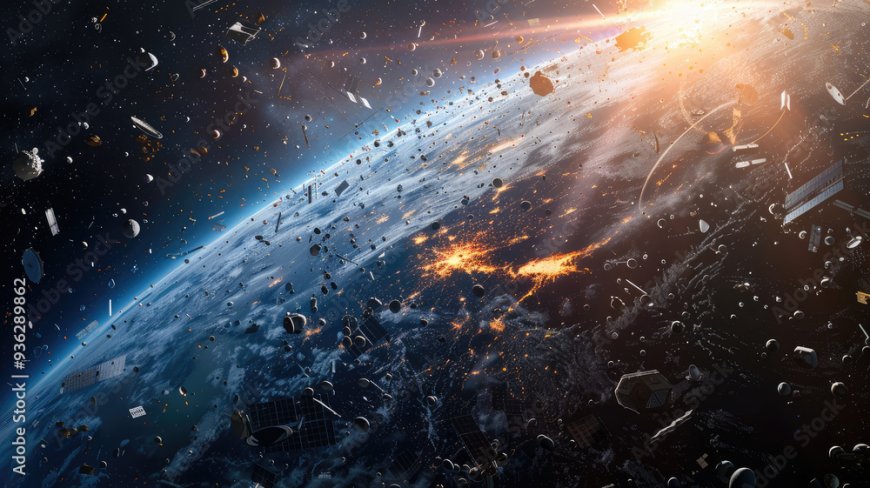The Silent Threat: How Space Debris Endangers the Future of Space Exploration
Space debris poses a serious threat to future space exploration. Learn how orbital junk impacts satellites, astronauts, and missions, and what solutions exist to clean up space.

Space exploration has always symbolized human progress and curiosity, pushing the boundaries of what we know about the universe. However, a growing issue threatens future missions—space debris. The increasing accumulation of defunct satellites, spent rocket stages, and other fragments orbiting Earth has turned space into a hazardous environment. As space agencies and private companies plan ambitious missions, addressing this challenge is crucial for the sustainability of space travel.
What is Space Debris?
Space debris, also known as orbital debris or space junk, consists of human-made objects that no longer serve a purpose. These include:
- Defunct Satellites – Old, non-operational satellites left floating in space.
- Rocket Stages – Used-up parts of rockets that remain in orbit after launching payloads.
- Fragmented Debris – Shattered pieces from explosions, collisions, or dismantled spacecraft.
- Lost Equipment – Items like tools, bolts, or even paint chips that have drifted away from spacecraft.
These objects travel at speeds of up to 28,000 km/h (17,500 mph), making even tiny fragments a significant threat.
How Space Debris Affects Future Space Exploration
1. Increased Collision Risks
The Kessler Syndrome, proposed by NASA scientist Donald Kessler in 1978, suggests that as space debris accumulates, collisions between objects will create even more debris, leading to a self-sustaining cycle. This growing cloud of junk increases the chances of collisions with operational satellites, space stations, and crewed missions.
- Example: In 2009, an inactive Russian satellite, Cosmos 2251, collided with an active Iridium communication satellite, creating thousands of new debris fragments.
2. Threat to the International Space Station (ISS) and Astronauts
The ISS, which orbits Earth at about 400 km (250 miles), regularly adjusts its position to avoid space debris. Even a small piece of metal the size of a marble can puncture a spacecraft, posing a severe risk to astronauts.
- Example: In 2021, astronauts aboard the ISS had to take shelter in their escape capsules when debris from an anti-satellite missile test passed dangerously close.
3. Obstructing Future Missions
Upcoming missions to the Moon, Mars, and beyond will require safe and reliable transit through Earth's orbit. An increasing number of debris fields could make launching new missions riskier and costlier.
- SpaceX’s Starship and NASA’s Artemis program may face increased risks when navigating through low Earth orbit.
4. Impact on Satellite Networks
With the rapid expansion of satellite constellations like Starlink (by SpaceX) and OneWeb, the risk of debris-related accidents is growing. A collision in these networks could disrupt global internet services, weather monitoring, and navigation systems.
Efforts to Mitigate Space Debris
1. Active Debris Removal (ADR)
Several technologies are being developed to capture and remove space junk, including:
- Harpoons and Nets – Designed to catch and drag debris back into Earth’s atmosphere, where it burns up.
- Laser Systems – High-powered lasers could nudge debris into safer orbits or deorbit them entirely.
- Electromagnetic Tethers – Devices that slow debris down, causing them to fall toward Earth naturally.
2. Designing Self-Deorbiting Satellites
Companies are working on satellites that deorbit themselves at the end of their operational lives. This can be done by using onboard propulsion systems or by deploying large sails to increase atmospheric drag.
3. International Policies and Regulations
Space agencies and governments are strengthening regulations to minimize debris creation.
- The United Nations Office for Outer Space Affairs (UNOOSA) and agencies like NASA, ESA, and Roscosmos are working to enforce sustainable space policies.
- The "25-year rule" requires satellites in low Earth orbit to deorbit within 25 years after the end of their mission.
4. Sustainable Space Practices
SpaceX, Blue Origin, and other private companies are designing reusable rockets to reduce debris generation. Reusability minimizes the number of discarded parts left floating in orbit.
What the Future Holds
If left unchecked, space debris could make parts of Earth’s orbit unusable for future exploration. However, with international cooperation, advanced technology, and stricter regulations, a sustainable future in space is achievable.
As space becomes more commercialized, the responsibility of maintaining a clean orbital environment falls on both governments and private entities. The next decade will be critical in shaping how humanity manages this silent but growing threat.
Conclusion
Space debris is a pressing challenge that requires immediate and long-term solutions. As we venture further into space, addressing this issue will be essential to ensuring the safety of astronauts, satellites, and future missions. With technological advancements and global collaboration, we can keep space open for exploration and innovation for generations to come.
What's Your Reaction?
 Like
0
Like
0
 Dislike
0
Dislike
0
 Love
0
Love
0
 Funny
0
Funny
0
 Angry
0
Angry
0
 Sad
0
Sad
0
 Wow
0
Wow
0



















































